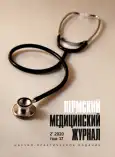Features of effect of low-intensity laser irradiation on prokaryotic and eukaryotic cells
- Authors: Godovalov A.P.1, Yakovlev M.V.1, Batog K.A.1, Remennikova M.V.2, Bykova L.P.1, Pastukhov D.M.1
-
Affiliations:
- E.A. Vagner Perm State Medical University
- Perm Federal Research Center UB RAS
- Issue: Vol 37, No 2 (2020)
- Pages: 48-53
- Section: Original studies
- URL: https://journals.rcsi.science/PMJ/article/view/34263
- DOI: https://doi.org/10.17816/pmj37248-53
- ID: 34263
Cite item
Full Text
Abstract
Objective. To study the possibility of using LED blue, red, and green radiations of a new apparatus to eliminate prokaryotic cells and maintain human cell viability. Currently, laser technologies are widely used in medical practice. However, there are relatively few studies on the effect of laser radiation with similar parameters on the viability of prokaryotic and eukaryotic cells.
Materials and methods. As a radiation generator, the LFDT-02 diode medical laser of a new type from the Perm Scientific and Production Instrument-Making Company was used. Staphylococcus aureus 66G cultures were irradiated with a different wavelengths laser (exposure time – 2 min, power – 22 mV). After that, the viability of microorganisms was evaluated by direct seeding on nutrient media. To study the effect of laser radiation on macroorganism cells, fasting samples of buccal epithelium were obtained in 17 practically healthy volunteers aged 20–25 years with an intact periodontium and dentition, without somatic pathology. To assess cell viability, a vital dye was used – 0.1 % trypan blue solution. The exposure time and power do not differ from those for the studied S. aureus strain. To assess the morphological changes of epithelial cells, preparations were prepared for microscopy, which, after fixation, were stained according to the Romanovsky-Giemsa method.
Results. When evaluating the effect of laser radiation, especially in a clinical setting, it is necessary to take into account its possible effect not only on cells of conditionally pathogenic microorganisms, but also on human cells. In the present study, it was shown that laser radiation with a power of 22 mV allows one to achieve a bacteriostatic effect against S. aureus but it also significantly reduces the viability of buccal epithelial cells, that can be considered, on the one hand, as a side effect of laser radiation and, on the other hand, the removal of dying cells filled with microorganisms, can enhance the effect of ongoing therapy.
Conclusions. Based on the results obtained, it can be concluded that the laser radiation of a diode laser with a wavelength of 405 nm (blue) and 650 nm (red) has a pronounced bacteriostatic effect. However, a significant damaging effect of red radiation on macroorganism cells was found.
Full Text
##article.viewOnOriginalSite##About the authors
A. P. Godovalov
E.A. Vagner Perm State Medical University
Author for correspondence.
Email: AGodovalov@gmail.com
кандидат медицинских наук, ведущий научный сотрудник ЦНИЛ, доцент кафедры микробиологии и вирусологии
Russian Federation, PermM. V. Yakovlev
E.A. Vagner Perm State Medical University
Email: AGodovalov@gmail.com
student, Stomatological Faculty
Russian Federation, PermK. A. Batog
E.A. Vagner Perm State Medical University
Email: AGodovalov@gmail.com
student, Stomatological Faculty
Russian Federation, PermM. V. Remennikova
Perm Federal Research Center UB RAS
Email: AGodovalov@gmail.com
Head of Laboratory of Agrobiophotonics, Researcher
Russian Federation, PermL. P. Bykova
E.A. Vagner Perm State Medical University
Email: AGodovalov@gmail.com
Candidate of Medical Sciences, Associate Professor of Department of Microbiology and Virusology
Russian Federation, PermD. M. Pastukhov
E.A. Vagner Perm State Medical University
Email: AGodovalov@gmail.com
student, Stomatological Faculty
Russian Federation, PermReferences
- Фиалкина С.В., Алексеев Ю.В., Коно валова Г.Н., Луковкин А.В., Бондаренко В.М. Подавление жизнеспособности клеток стафилококков лазерным лучом 1270 нм. Журнал микробиологии, эпидемиологии и иммунобиологии 2012; 5: 70–73.
- Кокая А.А., Ведунова М.В., Митроши на Е.В., Козяков В.П., Мухина И.В. Влияние электромагнитного излучения на жизнеспособность гепатоцитов при токсическом действии гидразинов. Вестник Российской военно-медицинской академии 2013; 1(41): 136–142.
- Копаев С.Ю., Копаева В.Г., Сабурина И.Н., Борзенок С.А. Влияние излучения гелийнеонового лазера на состояние клеток лимбальной зоны глаза человека. Вестник новых медицинских технологий. Электронное издание 2015; 1: 2–16.
- Хохлова А.В., Золотовский И.О., По година Е.С., Саенко Ю.В., Столяров Д.А., Ворсина С.Н., Соколовский С.Г., Фотиади А.А., Лямина Д.А., Рафаилов Э.У. Воздействие лазерного излучения с длиной волны 1265 нм на культуру клеток аденокарциномы человека. Наноиндустрия 2019; 12(2): 86–95.
- Конин Ю.А., Быкова Л.П., Яковлев М.В., Батог К.А., Годовалов А.П., Ременникова М.В. Особенности воздействия лазерного диодного излучения с длиной волны 650 нм на эпителиальные клетки человека. Материалы Международной научно-технической конференции с элементами научной молодежной школы, посвященной 20-летию ведущей научной школы России «Волоконно-оптическое приборостроение». Пенза 2018; 126–127.
- Мельник К.Н., Баишева Г.М., Гильмия рова Ф.Н., Аллатова Т.А. Саливадиагностика как метод определения иммунологической адаптации к учебному стрессу в условиях различного питьевого поведения. Клиническая лабораторная диагностика 2018; 63(6): 353–357.
- Louis K.S., Siegel A.C. Cell viability analysis using trypan blue: manual and automated methods. Methods Mol Biol 2011; 740: 7–11.
Supplementary files






